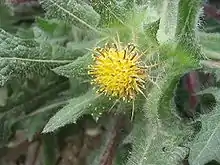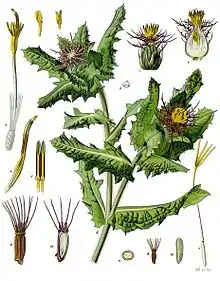Cnicus
Cnicus benedictus (St. Benedict's thistle, blessed thistle, holy thistle or spotted thistle), is a thistle-like plant in the family Asteraceae, native to the Mediterranean region, from Portugal north to southern France and east to Iran. It is known in other parts of the world, including parts of North America, as an introduced species and often a noxious weed. It is the sole species in the monotypic genus Cnicus. Other species once included in the genus have largely been reclassified to Cirsium, Carduus, and Centaurea.
| Cnicus | |
|---|---|
 | |
| Scientific classification | |
| Kingdom: | Plantae |
| Clade: | Tracheophytes |
| Clade: | Angiosperms |
| Clade: | Eudicots |
| Clade: | Asterids |
| Order: | Asterales |
| Family: | Asteraceae |
| Subfamily: | Carduoideae |
| Tribe: | Cynareae |
| Genus: | Cnicus L. |
| Species: | C. benedictus |
| Binomial name | |
| Cnicus benedictus L. | |
| Synonyms[1] | |
| |
Growth
It is an annual plant growing to 60 cm tall, with leathery, hairy leaves up to 30 cm long and 8 cm broad, with small spines on the margins. The flowers are yellow, produced in a dense flowerhead (capitulum) 3–4 cm diameter, surrounded by numerous spiny basal bracts.
The related genus Notobasis is included in Cnicus by some botanists; it differs in slender, much spinier leaves, and purple flowers.
In literature
In Shakespeare's comedy Much Ado About Nothing, "Carduus Benedictus", in tincture form, is recommended for a cold.[2]
Edibility
These thistles are not considered edible, unlike Cirsium, Arctium and Onopordum species; the leaves are considered unpalatable if not bitter.

References
- "The Plant List".
- Phillips, Roger (1990). The Random House Book of Herbs. Random House. pp. 173. ISBN 9780679732136. Retrieved 1 September 2019.
Much Ado About Nothing.
External links
| Wikimedia Commons has media related to Cnicus benedictus. |
- Cnicus Benedictus.—Blessed Thistle
- Spotted thistle entry in the public domain NCI Dictionary of Cancer Terms